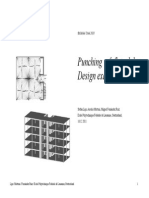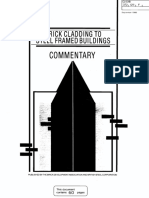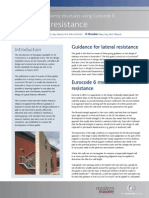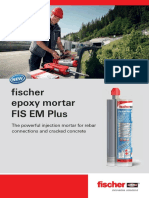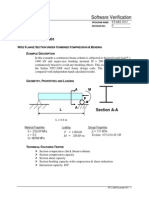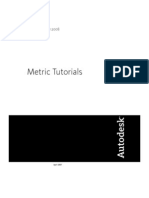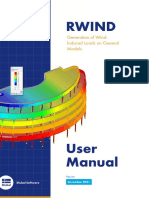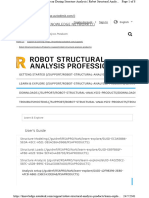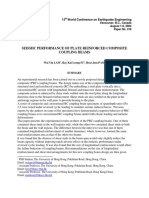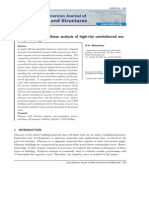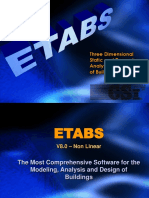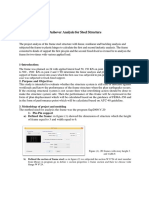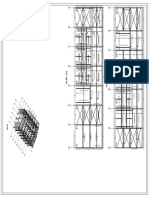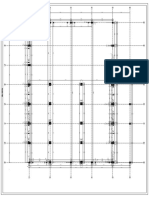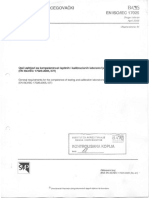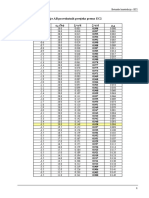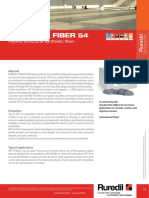0 ratings0% found this document useful (0 votes) 340 views15 pagesPushOver Analysis in Robot PDF
Copyright
© © All Rights Reserved
We take content rights seriously. If you suspect this is your content,
claim it here.
Available Formats
Download as PDF or read online on Scribd
pagina: 550 ROBOT Millennium versione 18.0. Manuale per Tutente
APPENDIX 5
NON-LINEAR PUSHOVER ANALYSIS
INTRODUCTION
The static nonlinear pushover analysis is a simplified approach that allows an engineer to understand
the performance of building structure for various design earthquakes.
The following restrictions are applied in current version:
+ Allnon-linear properties, which define the eventual structural failure during design earthquake, are
concentrated in so-called nonlinear pushover hinges. Other nonlinear effects (longitudinal forces,
P-Delta effect, traction-compression bars, etc.) is possible to be consider together with non-linear
hinges, but its do not play the decisive role in the damage behavior of building structures.
The nonlinear hinges are possible to be taken into account only for frame elements of structures
and for non-linear restrictions. The wall elements, modeled by shell finite elements (FE) and solid
‘ones, are not covered by the option.
© Non-linear hinges are considered as an independent non-linear links for each degree of freedom
in given node. It is neglected the interaction between different degrees of freedom. For example,
bending of bar in one plane does not depend on bending in another plane and longitudinal forces.
Such limitation will be removed in the next version.
* Location of each non-linear hinge is defined by the user.
Pushover analysis consists of following stages:
‘© Introduction of non-linear hinges in computational FE model.
Assignment of non-linear properties for hinges (force-displacement or moment-rotation diagrams)
Run modal analysis to activate of mass matrix (1 mode is enough).
Definition of lateral forces specimen. Note: Push lateral forces depend on type of mass matrix.
Assignment of control node and direction and ultimate push displacement value (when
displacement in control node and direction exceeds such threshold, nonlinear analysis is finished).
Assignment of parameters for non-linear analysis.
Run step-by-step non-linear analysis. Equilibrium state curve “shear forces versus controlling
displacement” V = V(D) is a result of non-linear analysis. Shear forces is defined as a sum of
reactions for given push direction caused by corresponding lateral force specimen.
= Conversion equilibrium states curve V = V(D) to ADRS format (acceleration displacement
response spectra) ~ derivation of capacity curve S:” = S:""(S,), where 52” is a spectral
acceleration and Sis a spectral displacement.
Capacity curve smoothing. Smoothed capacity curve is used for analysis of performance point.
Taking into account the reduction of vibration period due to hysteretic damping caused by strong
non-linear deformations of structure. Conversion of capacity curve to the axis “effective damping
versus period” Boy = By, (T)
+ Step-by-step search of the performance point as an intersection point between capacity curve
Se? = §2"(S,) and selected demand curve.
LATERAL LOAD DEFINITION
It offen happens for 3-D structures that first vibration mode produces a local vibration of a small part of
structure (local vibrations of single or few bars, local mode of plate, etc.). Such a vibration mode
usually is not representative for analysis of seismic response because makes small contribution into
seismic motion (has a small modal mass percentage). Therefore following algorithm is applied to
prepare a push mode - shape vector, which predefines a displacement vector during pushover
BN easees
Via Monte ol Peta, 120121 Milano, Tel 02 86 99 50 72 Fax 02 80 29 88 96
‘Email: informazioni@robobat.com�ROBOT Millennium versione 18.0. Manuala per utente pagina: §51
analysis. In general, future consideration is based on [2] with partial adaptation to computer
implementation.
+ K6,,=MI,, > ©,,, where K, M- stiffness and mass matrices respectively, lr - unitary
direction vector (has "1" on positions of translation displacements of direction dir = x <> y,z and
zeros on all other ones; x, y, z= push directions); dba: is taken as a push mode.
‘* Normalize push mode: ,, Z @,,, where p= y(MO,,,6,,
* Mass participation factor: T,, = (MJ, 4, )
* Search lateral forces as: Fy, =7.M@,,, where Yor iS a scalar multiplier. Shear force
Vor = Fars Tar)= ¥ ar(ML aes Bare) = FaeV ae
1 L
Therefore 7, ==—V,, and Fy, =——M@®,, *V’,,. Take Ver=1 because Ver play a role of
de ‘ar a =F ar * Visy
'ear pushover analysis and only spatial specimen of lateral forces
2
load parameter in non.
i
presents interest for us now. So F,, = —-M®,,.. In follows we will omit subscript dir because
each push direction requires specific pushover analysis.
EQuiLiBRiUM STATES CURVE. NONLINEAR ALGORITHM.
Usually characteristics of non-linear hinges are complex (see [1,2]) and contain a degradation
‘branches. Itoften leads to like-tooth shape of equilibrium states curves. Arc-length algorithm is applied
to‘overcome such difficulties.
The dialog-box of pushover analysis appears.
Case:
> Parameters —
Node number
| Direction.
| Maxinun displacement
Method of load defriton
| © Accotdrs to geviy in the given dection
LO User-defined
Fig. 10.5.1 Pushover analysis parameters: Node number, direction - number of nodes and direction, in
‘which the controlling displacement is set: Maximum displacement - maximum value of controlling
S%” =S°”(S,), where Sa, Sy -
spectral acceleration and spectral displacement. The function Ss” =S'"(S,) is a capacity
‘spectrum. Conversion procedure consists of following: for each point {D,V} « V = V(D) is derived
corresponding point for capacity spectra {S,,S, }= S2” = So" (S,) by means
Vv v v
(10.5.1)
= = mass percentage for push mode, M,, = Mi =(MIy.,/,,) - total mass of
‘structure; W - weight of structure; g - ground acceleration.
where
HD
To,’
Where «o - such component of push mode vector &®, which corresponds to (possesses the same node
and direction) controlling displacement D.
(10.5.2)
Sy
In general, V = V(D) usually is a non-linear function. The Ss = S:""(S,) equation is also a non-
linear function (see Fig.10.5.2). Each point on such curve is associated with period T. Evolution of
non-linear deformations leads to change of free vibration period. It is known that T=const on ADRS
diagram is a straight line, which pass through origin of coordinates. Therefore, for all points of linear
part of capacity spectrum period is the same and is denote Tin, This value is defined from solution of
linear equation set KX, = Fa, where K is a stiffness matrix, describing the linear behavior of structure,
and Far is a specimen of lateral forces. Let us denote: Din - component of solution vector Xae, which
has the same degree of freedom as controlling displacement D; Via - Sum of reactions (shear force),
caused by action of Fax. According to [2],
Sa
5.8
T =2z. (10.5.3)
After substitution (10.5.1), (10.5.2) to (10.5.3) it yields:
Ty = 2a] PP (10.8.4)
BA nor
Via Monte oi Pita, 120121 Milano, Tel 02 66 89 60.72 Fax 02 80 29 89 96
‘Email: informazioni@robobat.com�ROBOT Millennium versione 18.0. Manuale per Futente pagina: 653
Spec ween 3
3
‘speedport $8 sd
Fig. 10.5.2 Capacity spectrum in ADRS format
HYSTERETIC DAMPING. THE /,, (T) CURVE
Appearance of non-elastic deformations leads to arising of hysteretic damping. The corresponding
areas, shown on Fig. 10.5.3, ilustrate the energy dissipated per loop and maximum strain one. If the
vibration of given system associates with vibration of single degrees of freedom system with viscous
damping then equivalent viscous damping per full hysteresis loop is:
E,
=—=2 10.5.5)
4t Es, eee
Bo
where: Eo ~ energy dissipated per loop; Eso - maximum strain energy. Energy dissipated per loop Ep
and maximum strain energy Esa is possible to define from consideration of Fig. 10.8.3:
Ep = ( fs.as, - ret) Eygy = Area(AOAB) (10.56)
Effective damping is defined as:
Buy =*By + 0.05 (10.57)
Fl ena
|-20121 Milano, Tel 02 86 99 50 72 Fax 02 80 29 89 95.
'Emall informazioni@robobat.com
Via Monte di Peta,�pagina: 554 ROBOT Millennium versione 18.0. Manuate per utente
where: 0.05 is a viscous damping, x - factor is taken according to Fig.8-15 from [2].
Sa
current point of capacity
Sd
secon
Fig. 10.5.3 Area of curvilinear figure, restricted by capacity curve $= $:""(S,,) and lines AKO, is
‘a % of hysteresis parallelogram area and presence energy dissipated per loop by damping, Area of
triangle OAB presents maximum strain energy. AK is parallel to constant period line Tix = const.
Capacity curve is possible to present not only as S” = $3”(S,). but as Bar fer(T), because each
point of $<” = S"(S,,) possesses by period T (see equation 10.5.3) and effective damping fea (see
10.5.5-10.5.7).
Integral from (10.5.6) is evaluated numerically for each point A = S5” = S"(S,,). Application of arc-
length algorithm allows one to derive the very complex capacity curves with tooth-ike reversible
branches, caused by degradation paths of non-linear hinge characteristics (see Fig. 10.5.4). Therefore
‘capacity curve $.*” = $"(S,,) is subjected to smoothing procedure before numerical evaluation of
(10.5.5-10.5.7). Smoothed capacity spectrum curve is defined on regular mesh; itis a single-valued
function in contrast to initial capacity curve. Such property is very important for correct evaluation of
(10.55-10.5.7). Therefore for following analysis only smoothed capacity spectrum curve is used.
FR enwae
Via Monte di Pita, |-20121 Milano, Tel 02 86 99 50 72 Fax 02 80 29 89 96
‘Email: informazioni@robobat.com�ROBOT Millennium versione 18.0. Manuale per utente pagina: 585
‘capacity spectrum curve}
bott ea 3
Fig. 10.5.4 Capacity spectrum and smoothed capacity spectrum curves. Its obtained from real
example.
DEMAND CURVE. SELECTED DEMAND CURVE. PERFORMANCE POINT
When moving along nontinear capacity cuve S;" =S-"(S,) (S, €[0,Si"], where
5; = sup{S,,} is defined by last point of equilibrium states curve), period T and effective damping
Ber(T) are changing. Therefore each point on capacity curve So” = S"”(S,) (Bs = Pex(T)) defines
the corresponding reduced (demand) response spectra. cuve S™ =S"™(S,).
The,“ = SR, x3" in constant acceleration range of spectrum and S’™ = SR, x St" in
constant velocity range of spectrum (see Fig. 8-14 from [2]). The S‘'*"* is an acceleration spectra
from elastic response spectrum (5% damped).
5 q. RoboBAT
‘Via Monte di Piet -20121 Milano, Tel 02 86 99 60 72 Fax 02 80 29 89 96
‘Email: informazioni@robobat com�pagina: 556 ROBOT Millennium versione 18.0. Manuale per lutente
_Blastic response spectra (5% damped)
_ Reduced response spectra (/3, -- (Z; ) damped)
© Performance point
3_-copacity spectra
educed response spectra B, i (T, aamped)
_-selected demand spectra
Sa
Fig. 10.5.5 Evaluation of capacity, reduced and selective demand spectrum curves. Performance point
is an intersection of capacity and selective demand curves.
The point {S"™,S,} «5 = S’™(S,,), defined by given Ss from capacity spectra $°" = S°*(S,),
we call as a selected point. Therefore the motion along capacity curve 5;"” = 3."(S,,)give rises the
collection of selected points {S",S,}for S, €[0,5;“"], which is called a selected demand
spectrum curve S“" = S“"(S,). The intersection between capacity curve and selected demand
‘one defines a performance point. The scheme explanation is presented on Fig. 10.5.5. Until points
{5,55} belong to linear part of capacity spectrum diagram, T = Tig => fier = 0.05 = 5%. Point 1 is
projected to elastic response spectra as 1’. The demand spectra for such points are a part of elastic
response spectra from zero to limit of linear behavior. It is necessary to define for non-linear part of
capacity spectra: {S,,55"} = {.By }=> SR, SR, = 1S,.85"}
Points 2, 3 define the corresponding projections 2’, on appropriate reduced spectrum curves. The
collection of such points creates the selective demand spectra curve. Intersection between capacity
and selective demand curves defines a performance point.
PUSHOVER CURVE DIALOG BOX
Press Results / Advanced / Pushover curve to display pushover curve dialog box. Choose
Displacement - reaction sum option to show shear force - controlling displacement diagram V = V(D)
(Fig. 10.5.6.A).
Selection of capacity spectrum option (Fig. 10.5.6.8) leads to computations of capacity spectrum
curve S’” = S°7(S,), smoothed capacity spectrum curve, fe = Ber(T) curve, selected demand
spectrum curve Si" = S‘*"(S,) and search of performance point. The Normal and Smoothed
options allow one to display capacity spectrum curve and smoothed capacity spectrum curve,
respectively. The Selected demand option handles by appearance of selected demand spectrum one,
which is computed on the base of seismic coefficients C, , C, and smoothed capacity spectrum curve.
a
Via Monte di Piet, 1.20121 Milano, Tel 02 86 99 50 72 Fax 02 80 29 89 96
‘Email: informazioni@robobat.com�ROBOT Millennium versione 18.0. Manuale per Tutonte pagina: $57
Fig. 10.5.6 Pushover curve dialog box
Structure damping parameters allows one to set the structural behavior type (see [2]) and assign the
kappa-factor (see 10.5.7) according to [2, Fig. 8-15] or given by the user. If you want to assign your
‘own dependencies « = (By), check the Other option and correct the default values of x, fo. The
‘meaning of Point1 and point2 is presented on the figure below.
Bi Meas
‘Via Monte di Peta, 20121 ‘Tol 02 8 99 50 72 Fax 02 80 29 89 96
Email: informazioni@robobat.com�pagina: 558 ROBOT Millennium versione 18.0. Manuale per utente
Kappa factor
Beta 0
Fig, 10.5.7 Point and point 2 interpretation
In current version viscous damping is taken as 5% (constant value).
Auxiliary grid parameters allows one to display the lines of constant period (period values are
assigned in appropriate edit boxes) and the reduced spectra curves for given effective damping
(effective damping values are assigned in appropriate edit boxes). Such curve-linear grid must simplify
the orientation on S,, S, plane.
The coordinates of performance point are presented under separator, if performance point is found.
Otherwise, zeros values appear. To display all coordinates of performance point click right mouse
button mouse and select Table columns option. Another useful management of graphics is stil
available for you, when right mouse button is pressed.
The Damping-effective period option allows one to display flax = fer(T) curve (Fig.10.5.6.C). Pay
attention to the fact, that all points from linear part of capacity spectrum curve are mapped to single
point of Bar = Bax(T) with coordinates: T = Tin, Ben = 0.05.
REFERENCES
[1] FEMA 273, 1997, NEHRP Guildelines for the Seismic Rehabilitation of Buildings, Developed by the
Building Seismic Safety Council for the Federal Emergency Management Agency (Report No. FEMA
273), Washington, D.C.
[2] ATC-40, Seismic evaluation and retrofit of concrete building, 1996.
LENGTH CONTROLLING METHOD FOR NON-LINEAR ANALYSIS
a
Via Monte di Piet -20121 Milano, Tel 02 86 99 60 72 Fax 02 80 29 89 96
Email informazioni@robobat.com�ROBOT Millennium versione 18.0. Manuale per Futente pagina: 559
When top point of equilibrium states curve is met the force-controlling incremental algorithm is fault.
Lndpecae
3
Top point 1
Top point 2
D
Controling dephicemere
stable equilibrium states =» ———
unstable equilibrium states
Fig. 10.5.8 Typical view of equilibrium states curve with top points
The force controlling approach is possible to apply when 0 < 2. < hs, where 3, corresponds to top point
1.1f.> i force controlling iterative process is still non-convergent.
Arclength algorithm allows one to pass all branches of equilibrium states without any serious
problem. The normal plane method [1,2] is applied. The non-linear algorithm with developed arc-
length strategy is presented below.
Input parameters: tnx - maximum value of load parameter; Dna - maximum value of controling
displacement; NoSteps ~ number of assumed increments; Nolter ~ number of euilibrium iterations;
tol_F — tolerance for residual vector norm, tol_L ~ tolerance for load parameter.
© Start initialization
a=0
‘+ Loop over load increments: n= 0, 1, .
i=0
R, =0
Ad’ =0
ayy =d,
where: R, = 4,,.,F., —N(d,,.,)- residual vector, 2,,- current value of load parameter, F.,,-
extemal load, N(d/,_,) - vector of intemal forces; di, - current displacement vector.
‘+ Loop over equilibrium iterations: i= 0, 1, 2, ... < Nolter
Flere
Via Monte di Piet, -20121 Milano, Tol 02 86 99 50 72 Fax 02 80 29 89 96
‘Email: informazioni@robobat.com�pagina: 560 ROBOT Millennium versione 18.0. Manuale per utente
0_ or _update_tan gent _matrix_on_each_iteration)
Kr=Kz(di,,)
Krad, =F.,
fG>0)
R, = A,.4F., — Ndi,
IR,
Check _comergence:! th _F and _ break_loop_over_i
DF
KrAd’ =R, > Ad’
Set Ad,
Update '"!,,21", to the next iteration
ae + Ad, +AZ,Ad,
Aa = Anas + A,
End loop over i
IF ARS > Ag OP D” > Dy.) break _loop_over_n
D* -_controlling_displacement
End loop over n
The arc-length strategy sets the increment of load parameter on each iteration step. At the start of
solution (n=O; i#0) AZ) = Agu /NoSteps ;_AS = A2,,J+ Ad, AG, is adopted where AS is an
arc-length increment. At the start step of each iteration (i=0; n>0) A4, = AS/ i+ Ady Ad, and
Ad’ Ad?
1+ AdzAa,
plane method with updating of matrix only in each increment (as itis in modified Newton-Raphson
method).
when i>0 normal plane method gives The Fig. 10.5.9 illustrates the normal
DA nr
Via Monto di Peta, 120121 Milano, Tel 02 86 99 60 72 Fax 02 80 29 89 96
"Email: informaztoni@robobat.com�ROBOT Millennium versione 18.0. Manuale per Tutento pagina: 561
ah /
are] Avo
bl
‘
|
eeeeee sipuenese Snot Sit Soot =
Fig. 10.5.9 The normal plane method
‘
computation of load increment AZ,. Condition of orthogonality is: #-i=0 or
AAyAA, + Ad,Ad, =0 where Ad, = Ad,+A2,Ad, and Ad, = AA,Ad!; Ad?- Ad, for zero
iteration (i=0).
Such a condition of orthogonality allows one to define Ai, when i= 1, 2.
Its possible to show that determinant of |Kz| = 0 when singular point (limit top point or bifurcation one)
is achieved. The following condition is fulfilled: KrAd, =R,. When given point of plate load
parameter - controlling displacement belongs to equilibrium state curve, KrAd, =0 because
residual vector R,=0 (equilibrium conditions are satisfied exactly). Last expression is a
homogeneous linear equation set. Thus, if in some point |K:| = 0, it means that except for trivial
solution Ad, = 0 exists nontrivial one. The determinant [Kz] changes the sign the singular point is
passed. Developed algorithm controls the changing of sign of |Kz| determinant. If singular point is
passed appropriate waming informs the user that current equilibrium state is unstable.
Parameters for arc-length method can be set in the dialog box shown below.
Fenn
‘Via Monte di Pista, -20121 Milano, Tel 02 88 98 50 72 Fax 02 80 28,
‘Email: informazioni@robobat.com
36�pagina: 562 ROBOT Millennium versione 18.0. Manuale per utente
Fig.10.5.10 Parameters of arc-length method
Where: load increment number - NoSteps; maximum iteration number for one increment - Nolter;
‘maximum load factor - ima; node number, degree of freedom - assign node number and direction for
controlling displacement; maximum displacement for selected degree of freedom - Dini relative
tolerance for residual forces - tol_F; relative tolerance for displacements - tol_L.
Arc-length method is applied for non-linear pushover analysis and is strongly recommended when FE
model has the non-linear connections. The example illustrates the possibilities of arc-length method
which automatically allows us to get so complex equilibrium state curve (Fig.10.5.13) caused by
degradation branches of non-linear hinge characteristics (Fig.10.5.12).
BN. RoboBAT
Via Monto di Pita, |-20121 Milano, Tel 02 86 99 50 72 Fax 02 80 29 89 96
‘Email: informazioni@robobat com�ROBOT Milennium versione 18.0. Manuale per utente pagina: 563
Controlling node
non-linear hinges
Fig. 10.5.11 Example of frame structure loaded by lateral seismic forces
Pace aon focal
Fig. 10.5.12 Bending moment-rotation characteristic of non-linear hinges.
FN ennon
‘Via Monte di Plot, -20121 Milano, Tel 02 86 88 50 72 Fax 02 80 29 89 96
‘Email: informazioni@robobat com�pagina: 564 ROBOT Millennium versione 18.0. Manuale per utente
Load parameter
Controling displacement
Fig. 10.5.13 Equilibrium states curve. Like-tooth paths are caused by degradation branches of non-
linear hinge characteristics.
REFERENCES
1, E.Hinton, NAFEMS. Introduction to nonlinear finite element analysis, Glasgow, 1992
2. E-Ramm, Strategies for tracing non-linear responses near limit points. Non-linear finite element
analysis in structural mechanics, (Eds. W.Wunderlich, E.Stein and K.J.Bathe), Springer-Verlag,
New York, 1981
BN. RoboBAT
Via Monto ai Pita, |-20121 Milano, Tel 02 86 99 60 72 Fax 02 80 29 89 96
‘Email: informazioni@robobat.com
